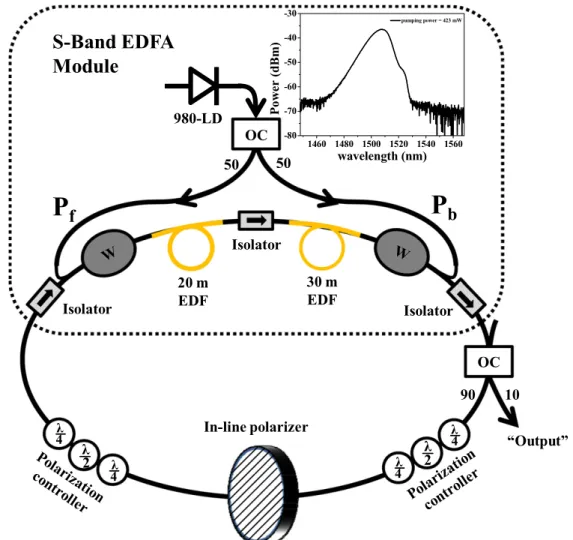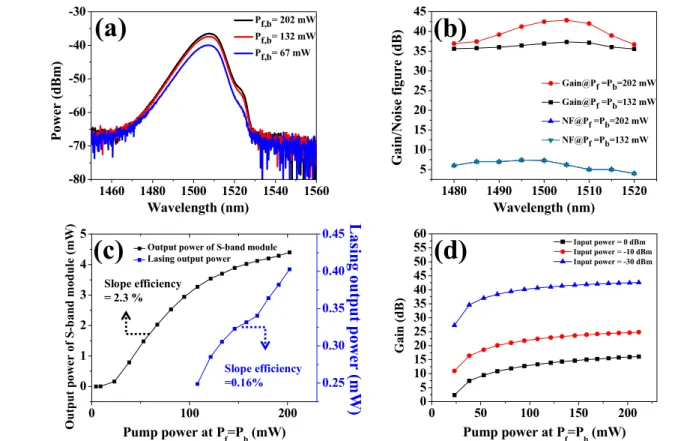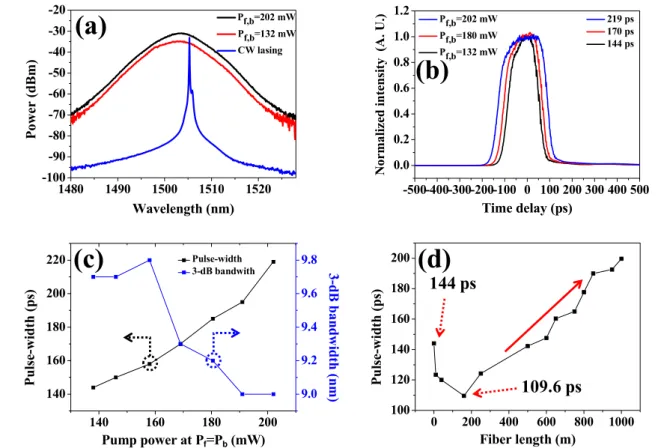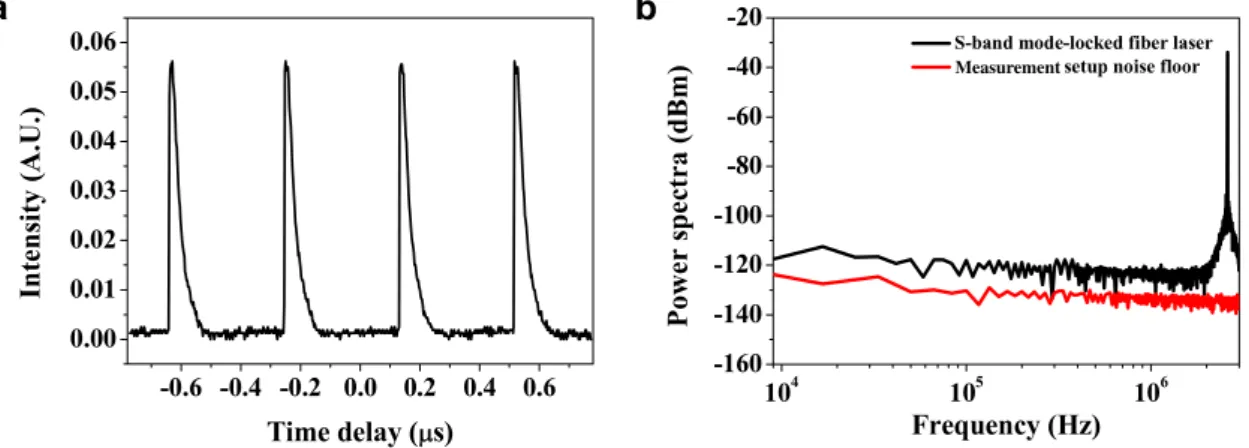This content has been downloaded from IOPscience. Please scroll down to see the full text.
Download details:
IP Address: 140.113.38.11
This content was downloaded on 28/04/2014 at 23:40
Please note that terms and conditions apply.
S-band pulse generation by polarization additive-pulse mode-locking in an erbium-doped
all-fiber ring laser
View the table of contents for this issue, or go to the journal homepage for more 2014 Laser Phys. Lett. 11 015105
(http://iopscience.iop.org/1612-202X/11/1/015105)
|Astro Ltd Laser Physics Letters
Laser Phys. Lett.11 (2014) 015105 (6pp) doi:10.1088/1612-2011/11/1/015105
Letter
S-band pulse generation by polarization
additive-pulse mode-locking in an
erbium-doped all-fiber ring laser
Ling-Gang Yang
1, Siao-Shan Jyu
1, Chi-Wai Chow
1, Chien-Hung Yeh
2,3and Yinchieh Lai
11Department of Photonics and Institute of Electro-Optical Engineering, National Chiao Tung University, Hsinchu 30010, Taiwan
2Information and Communications Research Laboratories, Industrial Technology Research Institute (ITRI), Hsinchu 31040, Taiwan
3Graduate Institute of Applied Science and Engineering, Fu Jen Catholic University, New Taipei 24205, Taiwan
E-mail:cwchow@faculty.nctu.edu.tw
Received 3 October 2013
Accepted for publication 8 November 2013 Published 26 November 2013
Abstract
An all-fiber S-band mode-locked Er-doped fiber ring laser operated at 1503 nm is experimentally demonstrated by utilizing the polarization additive-pulse mode-locking (P-APM) mechanism. To the best of our knowledge, it is the first P-APM mode-locked fiber laser operating in the S-band. The gain medium is an S-band Er-doped fiber amplifier (EDFA) composed of two Er-doped fiber stages with the technique of depressed-cladding to cut off the fundamental mode. Stable single-pulse operation is achieved within the available pump power range. Besides, characterization of the S-band EDFA module, such as the wavelength
dependences of the gain and noise figure, the slope efficiency, as well as the dependence of the pump power on the gain for different input powers is performed. In addition, analysis of the proposed S-band mode-locked fiber laser, such as the pump power dependence of the pulse-width and optical bandwidth, and pulse-width compression is also provided. Keywords: fiber lasers, fiber optics, communication optical
(Some figures may appear in colour only in the online journal)
1. Introduction
The bandwidth demand of optical fiber communication continues to grow; this has caused insufficient bandwidth and channel capacity when only the C-band (1530–1565 nm) is used. A great deal of research is focused on the nearby L-band (1565–1625 nm) to expand the available bandwidth [1–3]. As the wavelength range of typical erbium-doped fiber (EDF) lasers can only cover the C- and L-bands, less research effort is devoted to the S-band (1460–1530 nm).
Recently, more and more applications have required the use of the S-band, such as in biophotonics and photodynamic
therapy. For example, a facial resurfacing treatment can be implemented using a 755 nm Q-switched alexandrite laser [4–6], which can be constructed by frequency doubling an S-band mode-locked laser with lower repetition rate and longer pulse-width. Several approaches for developing S-band optical amplifiers have been reported. For example, erbium-doped fiber amplifiers (EDFAs) with depressed-cladding [7] as well as thulium-doped fiber amplifiers (TDFAs) [8] have been proposed to provide the optical gain in the S-band. Besides, some research effort has also been devoted to the demonstration of continuous-wave (CW) fiber lasers in the S-band by using various techniques [9, 10], while
Laser Phys. Lett.11 (2014) 015105 L-G Yang et al
Figure 1. The experimental setup of the proposed mode-locked fiber laser. 980-LD: 980 nm pump laser diode; OC: optical coupler; W: 980/1480 nm WDM coupler; EDF: erbium-doped fiber; Pf: forward pump power; Pb: backward pump power. Inset: ASE spectrum of the S-band EDFA module.
there are very few research results on the demonstration of mode-locked pulse fiber lasers in the S-band [11].
In this work, an all-fiber S-band mode-locked fiber ring laser operated at 1503 nm is proposed and experimentally demonstrated with a long cavity length. An EDFA with depressed-cladding is employed for building the mode-locked fiber laser in the S-band due to the advantages of simplicity, reliability and low cost. Based on the polarization additive-pulse mode-locking (P-APM) mechanism [12], mode-locked pulse trains are stably generated. To the best of our knowledge, this is the first time that a P-APM mode-locked fiber laser has worked in the S-band successfully. The gain medium is an S-band EDFA module (S-EDFA) composed of two EDF stages implemented by the fundamental mode cutoff effect of depressed-cladding fibers. A single power-sharing 980 nm pump laser diode (980-LD) is utilized which affords
an available pump power (Pf,b) = 202 mW for both the
forward pump power (Pf) and the backward pump power
(Pb). CW lasing is initially produced at a lower pump power
of 67 mW. The mode-locked pulse can be successfully generated at a pump power of 132 mW. The observed 3 dB optical bandwidth under mode-locking is around 10 nm. The repetition rate is 2.6 MHz. Besides, characterization of the
S-band EDFA module, such as the wavelength dependences of the gain and noise figure (NF), the slope efficiency, as well as the dependence of the pump power on the gain for different input powers is performed. Furthermore, analysis of the proposed S-band mode-locked fiber laser, such as the pump power dependence of the pulse-width and optical bandwidth, and pulse-width compression is also provided.
2. Experimental setup
Figure1shows the experimental configuration of the S-band mode-locked fiber laser. It is composed of an S-band EDFA module (S-EDFA), two polarization controllers (PCs), an in-line polarizer, and a 1 × 2 and 90:10 optical coupler (OC). Furthermore, the S-EDFA consists of a 50 m EDF with a
dispersion parameter D at 1500 nm of −57 ps nm−1 km−1
while the other fibers in the cavity are 27 m standard single-mode-fibers (SMF-28) with D of 15 ps nm−1 km−1. Hence, the fundamental frequency and net dispersion were estimated as around 2.6 MHz and +3.12 ps2, respectively.
For the S-EDFA, we utilized the fundamental mode cutoff effect of depressed-cladding fibers for S-band output.
Laser Phys. Lett.11 (2014) 015105 L-G Yang et al
Figure 2. (a) Optical spectra of the S-band EDFA module under different pump powers (Pf=Pb). (b) Wavelength dependences of the gain and NF of the S-band module. (c) The slope efficiencies of the S-band ASE output power and the lasing power. (d) The dependence of the pump power on the gain for different input powers.
A depressed-cladding fiber can be designed to possess a fundamental mode (LP01) cutoff near 1530 nm [7]. The
fabrication uses standard modified chemical vapor deposition (MCVD) and composition processes. The composition of the core is approximately 2.5% GeO2, 5.5% Al2O3, and 92%
SiO2, with 0.15% erbium while the depressed-cladding is
approximately 3% fluorine, 0.5% P2O5, and 96.5% SiO2. The
diameters of the core and cladding are 4 µm and 22 µm,
respectively. The numerical aperture of the core, relative to the depressed-cladding, is 0.22.
In this demonstration, the S-EDFA consists of two stages, with EDF lengths of 20 m and 30 m, respectively. A single pump laser diode power shares (50:50) for the two stages. The EDF is pumped via WDM couplers exhibiting 1 dB loss. A bidirectional pumping configuration is necessary in our laser to reduce the loss when pulses propagate in the gain module. The optical isolator between the two stages can reduce the backward ASE and improve the noise performance. The optical isolators at the input and output of the EDFA module ensure unidirectional operation of the ring laser to prevent backscattering light and to reduce the initial amplitude fluctuations of adjacent modes to favor the self-initiation of mode-locking. The two PCs and the in-line polarizer implement the P-APM effect by first transforming linear light polarization into elliptical polarization; then the polarizer transforms the nonlinear polarization rotation into nonlinear amplitude modulation. A 90:10 OC is used to tape out 10% of the optical power in the fiber laser cavity.
3. Experimental results
The optical ASE spectra of the S-EDFA are shown in figure 2(a) with different pump powers (Pf,b), measured by an optical spectrum analyzer (OSA). The ASE spectra are centered at 1503 nm in the range from 1470 to 1530 nm and the optical 3 dB bandwidth (1λ3 dB) is around 13.7 nm. To
characterize the S-EDFA, several parameters are measured, such as gain, NF, and slope efficiency. The wavelength dependences of the gain and NF are measured as shown in figure2(b). The gain is measured by a CW laser at 1500 nm with an input power of −30 dBm for different pump powers of Pf,b =132 mW and Pf,b=202 mW. For both of the pump
powers, the gain is larger than 35 dB. Furthermore, the lasing output power of the laser is measured by a power meter after the 10% output coupler port. From figure 2(c), the lasing output power is around 0.3 mW when the pump power is Pf,b =132 mW, and can reach 0.4 mW at an available pump
power of Pf,b =202 mW. Hence, the maximum circulating
power is 3.6 mW in the ring laser. Also, the slope efficiencies of the ASE output and the lasing output are indicated, as shown in figure 2(c). The slope efficiencies are 2.3% and
0.16% for the S-EDFA and lasing. Figure 2(d) shows the
dependence of the pump power on the gain for different input powers from −30 to 0 dBm. The maximum gain can reach 40 dB when the input power equals −30 dBm.
The optical spectra of the laser under mode-locking operation are shown in figure 3(a). Initial CW lasing at
Laser Phys. Lett.11 (2014) 015105 L-G Yang et al
Figure 3. (a) Optical spectra of the CW lasing and mode-locked cases. (b) Oscilloscope traces (time resolution = 25 ps) with the pump power at Pf=Pb=132, 180 and 202 mW. (c) Pump power dependence of the pulse-width and optical bandwidth. (d) Compression of the optical pulse-width.
1504 nm is observed by appropriately adjusting the two PCs
under a pump power of Pf,b =67 mW (shown by the blue
curve in figure 3(a)). When the pump power is increased above Pf,b =132 mW, broad optical spectra are observed,
indicating the successful achievement of mode-locking. The corresponding center wavelengths shift to 1503 nm. The time traces of pulses measured by a digital sampling oscilloscope are shown in figure 3(b) with three different pump powers
(Pf,b =132, 180 and 202 mW). In the measurement, a
photodetector (PD) (XPDV2120RA, u2tphotonics) connected to the oscilloscope is used to measure the signal. The bandwidth of the measurement setup is 50 GHz and the transient time is 13 ps. The dependence of the pulse-width on the pump power is then shown in figure3(c). A pulse-width of 144 ps at Pf,b=132 mW is initially observed. By increasing
the pump power while maintaining the other parameters, a gradually broadened pulse-width can be observed up to 220 ps when the pump power reaches the maximum available power of about Pf,b =202 mW. The pulse-width
increases monotonically with pump power. The 1λ3 dB
approximately approaches a constant for lower pump power (<Pf,b =160 mW), and decreases almost linearly for higher
pump power (>Pf,b = 160 mW). The 1λ3 dB values of
the mode-locked pulses are around 10 nm and 9 nm when
the pump power is Pf,b =132 mW and Pf,b =202 mW,
respectively. The optical bandwidth under mode-locking should be mainly limited by the gain bandwidth of the S-EDFA. Accordingly, the time–bandwidth-product (TBP) is
around 245 for all cases of pump power, indicating chirped pulses due to the relatively long fiber length in the cavity.
For compression of the pulse, we tested external-cavity dispersion compensation. The measured results are shown in figure3(d). Initially, the pulse-width is 144 ps. The full-width at half maximum (FWHM) pulse-width can be compressed down to 109.6 ps by a 160 m SMF. By increasing the length of the SMF, the FWHM pulse-width increases monotonically. The radio-frequency (RF) spectrum of the output pulse train is measured by an RF spectrum analyzer and is shown in figure 4. From figure4(a), we can observe that the cavity mode spacing is about 2.6 MHz. In the spectrum we do not observe frequency components other than the cavity harmonic components. There is also no relaxation oscillation frequency component around dc (direct current). This indicates that the laser should be well mode-locked without large amplitude fluctuations. The zoomed-in spectrum around the fundamental cavity frequency is also shown in figure 4(b) (using a span of 10 kHz and a resolution bandwidth of 10 Hz). It is clear that the measured results confirm that stable mode-locking is achieved since no intensity spike is found around the lasing modes.
The intensity stability of the laser is further examined with a longer-time oscilloscope trace (measured by a LeCroy 9450A) and the intensity noise spectrum near dc. The
measured oscilloscope trace is shown in figure 5(a). A
stable pulse train with 0.38 µs cycle time is obviously seen. It is clear that there is no intensity spike in the pulse
Laser Phys. Lett.11 (2014) 015105 L-G Yang et al
Figure 4. (a) The RF spectrum at Pf,b=132 mW pump power with a span of 17 MHz (resolution bandwidth = 10 Hz). (b) Zoomed-in RF spectrum around the fundamental cavity frequency (resolution bandwidth = 10 Hz).
a
b
Figure 5. (a) The oscilloscope trace shows stable pulse train generation with 0.38 µs cycle time. (b) The low frequency intensity noise
spectrum of the output pulse train (resolution bandwidth = 10 Hz).
train, no phenomenon of multi-pulses, and the time trace peaks have equal amplitudes. The measured intensity noise spectrum near dc is shown in figure5(b). An InGaAs-based photodetector is connected to the RF spectrum analyzer to perform the measurement and the average input optical power is maintained at −2 dBm to avoid intensity saturation. The measured spectrum is over the range from 10 kHz to 2.7 MHz. The noise floor (without any injected optical signal) is also plotted as a reference baseline. Again, no obvious noise peak is observed within the spectral range.
4. Conclusion
In this work, an all-fiber S-band pulse source centered at 1503 nm is proposed and experimentally demonstrated. The pulse trains are stably generated with a large normal dispersion cavity by the P-APM mechanism. To the best of our knowledge, this is the first time that a P-APM mode-locked fiber laser has worked in the S-band successfully. The gain medium is an S-band EDFA module composed of two EDF stages implemented by the fundamental mode cutoff effect of depressed-cladding fibers. Besides, characterization of the S-band EDFA module, such as the wavelength dependences of the gain and noise figure (NF), the slope efficiency, as
well as the dependence of the pump power on the gain for different input powers is performed. In addition, analysis of the proposed S-band mode-locked fiber laser, such as the pump power dependence of the pulse-width and optical bandwidth, and pulse-width compression is also provided.
References
[1] Lin G R, Chang J Y, Liao Y S and Lu H H 2006 L-band erbium-doped fiber laser with coupling ratio controlled wavelength tunability Opt. Express14 9743–9
[2] Yeh C H, Chow C W, Chen J H, Chen K H and Lu S S 2013 Broadband C- plus L-band CW wavelength-tunable fiber laser based on hybrid EDFA and SOA Opt. Fiber Technol. 19 359–61
[3] Yeh C H, Chow C W and Lu S S 2013 Using a C-band reflective semiconductor optical amplifier and linear cavity laser scheme for L-band multi-wavelength lasing Laser Phys. Lett.10 045108
[4] Rao J and Fitzpatrick R E 2004 Use of the Q-switched 755-nm alexandrite laser to treat recalcitrant pigment after
depigmentation therapy for vitiligo Dermatol. Surg. 30 1043–5
[5] Kent K M and Graber E M 2012 Laser tattoo removal: a review Dermatol. Surg.38 1–13
[6] Felton S J, Al-Niaimi F, Ferguson J E and Madan V 2013 Our perspective of the treatment of naevus of Ota with 1064-,
Laser Phys. Lett.11 (2014) 015105 L-G Yang et al
755- and 532-nm wavelength lasers Lasers Med. Sci. doi:10.1007/s10103-013-1332-3
[7] Vavassori P, Foroni M, Poli F, Cucinotta A and Selleri S 2005 S-Band EDFA with ASE suppression induced by bending loss of depressed-cladding active fiber Optical Amplifiers and Their Applications, Technical Digest (CD)Optical Society of America, 2005, paper MC5
[8] L¨uthi S R, Costa e Silva M B, Bastos-Filho C J A, Martins-Filho J F and Gomes A S L 2005 TDFA/Raman hybrid amplifiers covering the entire S-band pumped by a single laser IEEE Photon. Technol. Lett.17 2050–2
[9] Harun S W, Cheng X S, Saat N K and Ahmad H 2005 S-band Brillouin erbium fibre laser Electron. Lett.41 174–6 [10] Yeh C H, Huang T T, Chien H C, Ko C H and Chi S 2007
Tunable S-band erbium-doped triple-ring laser with single-longitudinal-mode operation Opt. Express15 382–6 [11] Yang L G, Jyu S S, Yeh C H, Lin S B, Chow C W and Lai Y
2013 Self-starting S-band mode-locked fiber ring laser by polarization additive pulse mode-locking Proc. CLEO Paper JTu4A.05
[12] Haus H A, Ippen E P and Tamura K 1994 Additive-pulse modelocking in fiber lasers IEEE J. Quantum Electron. 30 200–8



